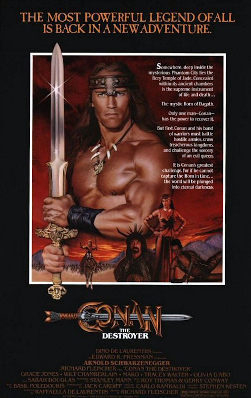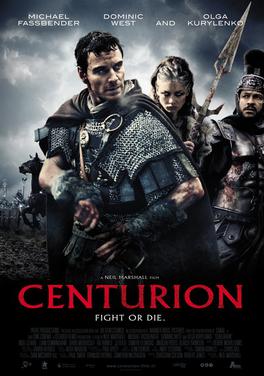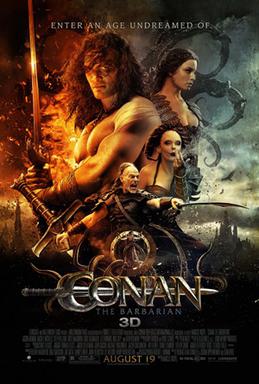 Like its predecessor, Conan the Destroyer didn't set cinema on fire. But in an industry of marginal profits, the film's considerable success at the box office made a third film set in the world of Robert E. Howard all but inevitable. That film, Conan the Conqueror - the long-promised story that shall also be told, of how Conan became a king in his own hand -, never left development hell; and for that we can thank the ignominious failure of the series spin-off Red Sonja.
Like its predecessor, Conan the Destroyer didn't set cinema on fire. But in an industry of marginal profits, the film's considerable success at the box office made a third film set in the world of Robert E. Howard all but inevitable. That film, Conan the Conqueror - the long-promised story that shall also be told, of how Conan became a king in his own hand -, never left development hell; and for that we can thank the ignominious failure of the series spin-off Red Sonja.Red Sonja's production was rushed compared to the two-year gap between the Conan films. I've remarked on the breakneck pace the Italian film industry was capable of in its glory days, and if Richard Fleischer did not quite match Mario Bava's feat of releasing two of his films twelve days apart, it's still worth noting that Conan the Destroyer left cinemas in August 1984 and principal photography for Red Sonja took place that same November, for a summer 1985 release. That sort of pace may be common in low-budget horror, but it's quite something for sword and sorcery, which calls for massive sets, landscape photography and epic battles.
Those three months during the autumn of 1984, however, saw the release of The Terminator. That film's massive success - a worldwide gross of $78 million, comparable to the Conan films but nothing to sniff at considering it had only a third of the sword-and-sorcery films' budget - suggested to Schwarzenegger that he had a legitimate, loincloth-free career ahead of him. When Red Sonja bombed, taking in less than $7m on a $17.9m budget, he abandoned the barbarian genre and became the action/comedy star - and eventually the politician and philanderer - we know and possibly still love today.
When Red Sonja (Brigitte Nielsen) rejects the lesbian advances of the evil queen Gedren (Sandahl Bergman), Gedren has her family murdered while Sonja is raped by her soldiers and left for dead before being revived by a spirit voice. (It's never revealed who this spirit - who speaks to Sonja only twice in the course of the film, never in a plot-relevant function - is, which strikes me as one of the tell-tale signs of a script that was butchered and stitched together again by some literary Leatherface.)
Later, somewhere else, a group of priestesses tries to destroy a dangerous talisman, but they're attacked and killed by the goons of Gedren, who wants the power of the talisman for herself to rule the world. Sonja's sister Varna (Janet Agren) manages to flee, but is shot in the back before being rescued by random hero-lord 'Kalidor' (Arnold Schwarzenegger). It remains one of the film's mysteries why it was felt necessary to create a character who is clearly Conan with the serial numbers filed off: legal reasons, perhaps. Anyway, Kalidor messily kills several of Gedren's goons (Red Sonja cranks up the gore to Conan the Barbarian levels again, after the tamer Destroyer) and carries the dying Varna off to Sonja, who has been trained as a mighty warrior by a vaguely Oriental sword-master (Tad Horino).
When Sonja finds out what's going on, she decides to stop Gedren, initally leaving Kalidor who nonetheless, as Tim Brayton puts it, 'just pops in like a wacky neighbor on a sitcom' during the film's first half. She fights and kills the warlord Brytag (Pat Roach) for no discernible reason and encounters Tarn (Ernie Reyes Jr.) and Falkon (Paul Smith), a child prince and his manservant who have lost their kingdom to Gedren's newly powerful forces. Eventually, the four make it through the wilderness, encountering exactly no people, and square off against Gedren and her magic tricks.
Though undeniably very bad - if Schwarzenegger's jest about punishing his progeny by subjecting them to this film were true, it would constitute child abuse - Red Sonja is at least as 'good' as Conan the Destroyer, and feels a lot better by mercifully coming in under ninety minutes. Written by two Britons, Clive Exter (who later wrote no fewer than twenty-three episodes of Jeeves and Wooster, if you can believe it) and George MacDonald Fraser (who co-wrote Octopussy), Red Sonja's plot is as unsteady and aimless as that of the preceding films, but it's a whole lot less padded, avoiding the cosmic tedium of Destroyer's sleepy second half. The worst thing you can say about is that it introduces that shopworn trope, the Annoying Kid; but at least Tarn turns heroic fairly early on.
At the same time, the casting departments must have been mad as a hatter convention, for the sheer number of series veterans re-cast in totally different roles makes viewing a profoundly baffling experience. Besides Schwarzenegger - who, as the film's most bankable star, is billed above the then unknown Nielsen - there's Bergman, who played Conan's true, sadly nameless love in Barbarian, rendered less recognisable by a mask covering half her face, a fairly terrible black wig, and a deliciously hammy performance. The casting of Pat Roach, who played the illusionist Toth-Amon in Destroyer, as the villainous Brytag is less justifiable, especially since his cameo is mere padding. Danish bodybuilder Sven-Ole Thorsen, however, takes the cake, with his third character in as many films.
Schwarzenegger's performance is, well, vintage Arnie: no-one could make a line like 'She's dead. [Pause.] And the living have work to do' sound quite so earnest yet hilarious. But let's consider Brigitte Nielsen for a moment. Twenty-one years old, with no real acting experience, her uninflected, wooden performance is truly horrendous in exactly that oddly fitting Schwarzeneggerian mould, and they're perfectly matched on set. But where the Austrian reached superstardom, Nielsen briefly became Mrs Sylvester Stallone, met Ronald Reagan, appeared in Playboy a couple of times and has lived out the rest of her career on reality television. Just a few weeks ago, Nielsen won the German version of I'm a Celebrity... Get Me Out of Here!.
Richard Fleischer, returning to the director's chair after Conan the Destroyer, largely keeps it steady. At some point, though, he must have decided to prove that a leopard can change its spots and also why it shouldn't, by serving up a couple of absolutely nonsensical first-person shots during sword-fighting scenes. It's in the special effects department that Red Sonja is a real let-down, however. Whether it was time or money, the film resorts to mattes - gorgeously painted mattes, I grant - where John Milius in his Barbarian days would probably have built a full set. Contrast the visuals of Conan the Barbarian with the pretty but totally artificial look of Red Sonja:
The costumes and sets, alas, are the series' weakest by far, preposterous without once looking striking. In one battle scene - I'm not making this up, I swear - one mook wears blue jeans, which I'm fairly sure were not invented in the Hyborian Age. And speaking of battles, the swordfighting - choreographed by stunt coordinator Sergio Mioni, I presume - is noticeably worse than in either of the earlier films. Saddled with a leaden script, poor effects and an extraordinarily lazy Ennio Morricone score, Red Sonja cannot help being terrible; but while not as rousing as the first film, it is at least less infuriating than Conan the Destroyer.
In this series: Conan the Barbarian (1982) | Conan the Destroyer (1984) | Red Sonja (1985) | Conan the Barbarian (2011)
















